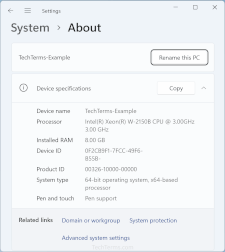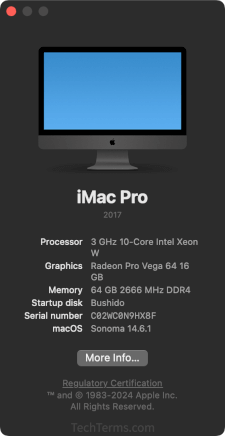Configuration
A system configuration refers to the technical specifications (or "tech specs") of a device. For a computer, the primary specs include the CPU type and speed, system memory (or RAM), graphics card (GPU), storage device type and capacity, and operating system. A detailed configuration may include the motherboard, network adapters (including Ethernet and Wi-Fi capabilities), Bluetooth connectivity, and I/O ports.
Below is an example configuration of a Dell Alienware gaming PC.
- CPU: Intel Core i9 14900KF (68 MB cache, 24 cores, up to 6.0 GHz)
- GPU: NVIDIA GeForce RTX 4090, 24 GB GDDR6X
- RAM: 32 GB (2 x 16 GB, DDR5, 5600 MT/s)
- Storage: 2 TB, M.2, PCIe NVMe SSD
- OS: Windows 11 Home
Understanding core specs like CPU, GPU, RAM, and storage is helpful when choosing a new computer or virtual system. For example, if you mainly use your PC for browsing the web and writing documents, you don't need a high-end CPU or lots of RAM, like someone who does video editing. If you play games on your PC, you might need a high-end video card, whereas an audio engineer only needs basic graphics capabilities. Generally, it's best to choose a system with slightly better specs than you need so that it will be sufficient for your current and future computing tasks.

 Test Your Knowledge
Test Your Knowledge
